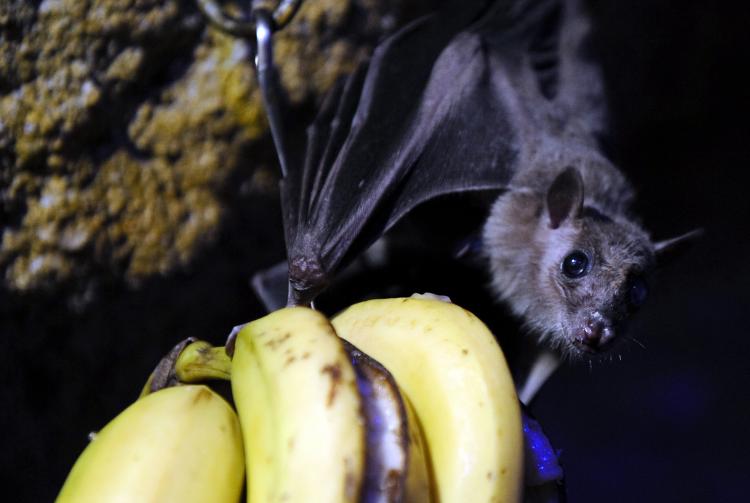Geomyces destructans is a fungus that is fairly new to science, yet researchers believe it is killing an alarming number of bats.
Bats play a critical role in maintaining healthy ecosystems and in agricultural systems. A recent analysis published in Science magazine revealed that pest control services provided by insect-eating bats save the U.S. agricultural industry at least $3 billion a year. White nose syndrome threatens them.
Named for the visible presence of a white fungus around the muzzles, ears, and wing membranes of affected bats, white-nose syndrome (WNS) has killed more than a million hibernating bats in eastern North America since it was discovered near Albany, N.Y. five years ago. The Department of the Interior’s U.S. Fish and Wildlife Service recently unveiled a national management strategy to address this deadly bat disease.
Since the syndrome was discovered in 2006, WNS has spread fast—infected bats are found in 18 states and four Canadian provinces. Secretary of the Interior Ken Salazar said the syndrome “threatens far-reaching ecological and economic impacts.”
“We’ve learned a lot in the past few years about the disease, but there is much more work to be done to contain it,” noted Salazar in a statement. “This national plan provides a road map for federal, state, and tribal agencies and scientific researchers to follow and will facilitate sharing of resources and information to more efficiently address the threat.”
The U.S. Fish and Wildlife Service says its national plan provides a coordinated management strategy for investigating the cause of the syndrome and finding a means to prevent the spread of the disease. Interior Department agencies have invested more than $10.8 million on this effort since 2007.
In September 2010, the U.S. Fish and Wildlife Service’s National Wildlife Refuge System began researching caves and abandoned mines in an effort to slow the spread of WNS. Since the syndrome was first documented, the service has been leading a national response that now includes more than 100 state and federal agencies, tribes, organizations and individuals.
In addition to research—which includes more than $3 million in funding to support ongoing projects looking for methods to control or cure the disease—the national response effort has also developed decontamination protocols to reduce the transmission of the fungus, surveillance strategies, and WNS diagnostic procedures.
The release of this new strategy coincided with the fourth annual WNS Symposium held in Little Rock, Ark., this week. The symposium featured the latest research from bat and wildlife disease on how to contain the spread, determine the cause, and find a cure for WNS.
Bats play a critical role in maintaining healthy ecosystems and in agricultural systems. A recent analysis published in Science magazine revealed that pest control services provided by insect-eating bats save the U.S. agricultural industry at least $3 billion a year. White nose syndrome threatens them.
Named for the visible presence of a white fungus around the muzzles, ears, and wing membranes of affected bats, white-nose syndrome (WNS) has killed more than a million hibernating bats in eastern North America since it was discovered near Albany, N.Y. five years ago. The Department of the Interior’s U.S. Fish and Wildlife Service recently unveiled a national management strategy to address this deadly bat disease.
Since the syndrome was discovered in 2006, WNS has spread fast—infected bats are found in 18 states and four Canadian provinces. Secretary of the Interior Ken Salazar said the syndrome “threatens far-reaching ecological and economic impacts.”
“We’ve learned a lot in the past few years about the disease, but there is much more work to be done to contain it,” noted Salazar in a statement. “This national plan provides a road map for federal, state, and tribal agencies and scientific researchers to follow and will facilitate sharing of resources and information to more efficiently address the threat.”
The U.S. Fish and Wildlife Service says its national plan provides a coordinated management strategy for investigating the cause of the syndrome and finding a means to prevent the spread of the disease. Interior Department agencies have invested more than $10.8 million on this effort since 2007.
In September 2010, the U.S. Fish and Wildlife Service’s National Wildlife Refuge System began researching caves and abandoned mines in an effort to slow the spread of WNS. Since the syndrome was first documented, the service has been leading a national response that now includes more than 100 state and federal agencies, tribes, organizations and individuals.
In addition to research—which includes more than $3 million in funding to support ongoing projects looking for methods to control or cure the disease—the national response effort has also developed decontamination protocols to reduce the transmission of the fungus, surveillance strategies, and WNS diagnostic procedures.
The release of this new strategy coincided with the fourth annual WNS Symposium held in Little Rock, Ark., this week. The symposium featured the latest research from bat and wildlife disease on how to contain the spread, determine the cause, and find a cure for WNS.







